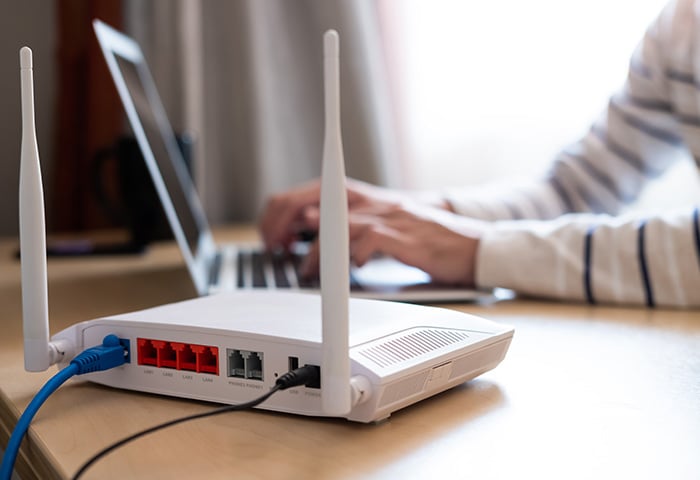What is a router?
A router is a hardware device that serves as the connecting point between a local network and the internet. Routers manage — or “route” — web traffic and data between devices on different networks, and they let multiple devices share the same internet connection.
Network routers are important intermediaries between network nodes and the public internet. Using the IP (internet protocol) system, routers manage internet traffic and direct data packets to the correct IP address. Without a router, your mobile, desktop, laptop, and smart appliances, would each need their own individual internet connection.
A router's definition can also be expanded to the creation of local networks. By funneling data between multiple networked devices, routers enable users within a particular organization to share files and communicate via a local network.
What does a router do?
A router manages communication between computer networks by forwarding internet traffic from one network node to another. Routers are like the air traffic control towers of the internet — with data packets zooming all over the place across networks, routers ensure that they arrive safely at the right destination.
Routers work out the fastest data path between unique IP addresses within a network according to what’s known as “metric value.” The router then follows specifically defined rules known as internet protocols to send data along the path with the lowest metric value. These protocols dictate how devices communicate with one another over the internet, and they apply to both public and private IP addresses.
How do routers work?
Internet routers work in tandem with a modem. As data packets arrive from connected devices, the router forwards them to the modem. The modem then sends the information to the relevant server, which is connected to the internet via its own router. The server then “serves” requested data packets back to the device, reversing the process.
When the internet traffic arrives at your router via the modem, it’s then forwarded to a particular IP address, ensuring it reaches the correct device. That's why internet protocols are so important. Your IP address is like a physical address where packages — or data packages in this case — need to be delivered.
 Internet data travels from the internet to a modem and is then sent by a router to your device. The process works the same in reverse.
Internet data travels from the internet to a modem and is then sent by a router to your device. The process works the same in reverse.
Modem vs router: Do I need both?
Yes, you need both a modem and a network router to connect to the internet, but nowadays both devices normally come together within a single piece of hardware. In the early days of the internet, most houses needed two separate devices, because modem and router uses were distinctly different.
In the days of dial-up internet delivered over telephone lines, separate modems were needed to configure and enable communication between digital devices and the analog signals used on telephone lines. But with modern fiber-optic and satellite internet connections, modems now play a slightly different role, simplifying home internet infrastructure.
What's the difference between a router and a modem?
A modem takes signals from your Internet Service Provider (ISP) via a coax cable connection, and converts them into signals your local devices can read — and vice versa. The connection established by the modem between your house or office and the wider internet is known as a wide area network (WAN). ISP throttling works by limiting bandwidth across the WAN.
The router assigns local IP addresses and creates a local area network (LAN), allowing your devices to connect to this internet service. Without a modem, all you’d have is your local network with no way to connect to the internet. But without a router in place, your modem and various networked devices wouldn’t be able to communicate with one another.
Different types of routers
There are various types of routers including wired, wireless (Wi-Fi), and core routers. Although all routers fulfill the same essential function, the type of router hardware you have will determine how exactly it works — primarily in terms of how it connects to the network.
Here’s a run-down of the different types of router, and what they mean.
Wired routers
Router devices that connect via network cables are called wired routers. Wired routers have no wireless capabilities and only have LAN router cable ports, meaning you must physically plug your devices into the router to make it work. If your computer router comes with a port that connects to a modem to communicate with the internet, you likely have a wired router.
Wireless routers
Wireless routers are now by far the most common type of home router. Also known as Wi-Fi routers, they include an antenna and wireless adapter that converts internet signals into radio waves (Wi-Fi) and allows devices to get online without a tethered connection.
If you have Wi-Fi internet, it means you have a wireless router by definition. There is still a cabled connection involved in wireless routers, but it's between the modem and the router, not between the router and network devices.
Core routers
Core routers sit at the heart of a network and manage the flow of data packets within the network, often relying on other routers for connectivity. A core router is typically used in large computer networks and is not something you will find at home.
When it comes to core routing vs edge routing, the clue is in the name — core routers operate at the center (core) of a large organizational network, whereas edge routers sit at the periphery of a network and maintain router-to-router connections to core routers.
 There are three types of routers: wired, wireless (Wi-Fi), and core. They all serve the same essential functions.
There are three types of routers: wired, wireless (Wi-Fi), and core. They all serve the same essential functions.
What are the key features of a router
In most cases, your ISP will provide a router and modem for you. But if you want to buy a router yourself, the important router features to look out for include speed, coverage, and the router’s connection mode. To know which router features to prioritize, you should consider what you’ll be using the network for, as working, gaming, and casual use all have different demands.
 Coverage and range
Coverage and range
Depending on the layout of your home, you may need multiple routers to ensure sufficient coverage. Large or unusually shaped homes will often struggle to get complete coverage with just one router, and other common household features such as thick walls, mirrors, and fireplaces can also weaken Wi-Fi signals.
If your Wi-Fi isn't working, insufficient router range may be the reason. But before you go out and buy multiple routers, try improving the connection by boosting your Wi-Fi signal strength or getting Wi-Fi extenders. When choosing a wireless router, consider the number and quality of its antennas, as this will impact range.
If slightly more range is needed to ensure full coverage, a useful hack is to use a mesh Wi-Fi network, which incorporates a main router and a series of additional routers to boost and extend the Wi-Fi signal throughout your home, and even enable outdoor access points.
 Performance
Performance
There are two main categories when it comes to router performance: single-band routers and dual-band routers. Whereas single-band routers communicate using the 2.4GHz frequency, dual-band routers broadcast simultaneously on both 2.4 and 5GHz frequencies using what’s known as the dual operating protocol.
The dual operating protocol enables faster speeds and better performance over longer distances, making dual-band routers particularly useful for large households, gamers, or those that experience interference from neighboring networks’ Wi-Fi signals.
 Speed
Speed
Super-fast router speeds are important if you want to watch videos without buffering and play games without lag, but it’s not the be-all and end-all. Internet speeds are also heavily dependent on other factors such as your ISP and the end-point hardware you’re using.
For instance, if you sign up for a service offering 30 megabits per second (Mbps), then having a router that transmits at 1 gigabit per second (Gbps) is still only going to give you 30Mbps. To fix a slow internet connection, start by looking at the speed limits imposed by your ISP contract. Then consider the age and capabilities of your device — it’s normal for computers to slow down over time.
 Wi-Fi functionality
Wi-Fi functionality
Some routers now enable guest networks, parental controls, user time limits, and network management via user-friendly apps. You also should consider the functionality of Wi-Fi security protocols such as WEP vs WPA vs WPA2. Wi-Fi security protocols can usually be configured in router settings, with WPA2 now considered the gold standard.
You should also keep in mind that there are various routing operating systems, each of which works slightly differently. The most common router operating systems are: MS-DOS, Microsoft Windows, and UNIX.
As router technology continues to advance, make sure you keep pace with fully updated firmware that allows your router to use all the latest protocols. Multiple-input, multiple-output technology (MU-MIMO) is one such development that enables Wi-Fi routers to communicate with multiple devices simultaneously, reducing wait time and improving network speed.
 Blending in aesthetically with your home
Blending in aesthetically with your home
Routers are conspicuous pieces of technology, so as well as performance specs, choose a router that fits in with the overall aesthetic of your home. You may want to match the brand of electronics already featured in your home. And even if you usually have your router tucked away in a cupboard, it’s worth thinking about how it will blend in with your existing set-up.
 Security
Security
Like all other networked devices, routers are susceptible to hacking. And having compromised your home network, hackers could install a router virus directly on your router, or target your other devices with malware or spyware. Make sure your router’s connection point isn’t an easy target by using security software that blocks cyberattacks at the point of entry to prevent router hacking.
Wi-Fi Protected Setup (WPS) on a router
Wi-Fi Protected Setup (WPS) is a router security feature that allows you to quickly and easily connect devices to a secure Wi-Fi network without worrying about where to find the network security key on your router or configuring Wi-Fi security protocol settings.
What does the WPS button on a router do?
The WPS button on a router allows you to automatically establish a Wi-Fi Protected Setup connection with certain devices. By pressing the router WPS button at the same time as the corresponding button on your WPS-enabled device, you can link them without needing to enter a password.
How to connect to a Wi-Fi network with WPS
The most common method of connecting to a Wi-Fi network with WPS is by pressing the WPS button on your router, followed by the WPS button on your device. This enables your router and device to discover and authenticate each other, and establish a secure network connection.
For devices that don’t have a WPS button, you’ll need to use an alternate method. This may involve finding a short PIN code displayed on your access point, and then entering it into your device to pair it with your router — consult your device manual for specific set-up guidance.
Is WPS safe to use?
It’s safe to use WPS to add devices to your network, but leaving WPS enabled is a security risk. That’s because the functionality that makes it easier to link devices to your router can also be exploited by hackers to gain access to your network via a brute-force password cracking attack on your WPS PIN. For this reason, it’s advisable to disable WPS on your access point once you’ve finished pairing devices.
Download AVG AntiVirus FREE to secure your router and devices
Your home network is only as strong as its weakest link. Without robust router protection, hackers could snoop on your internet traffic, record passwords and other account information, or even steal your credit card details. That’s why having comprehensive security that covers all your networked devices is so important.
With AVG AntiVirus FREE there are no easy backdoors for cybercrooks to target. Thanks to an enhanced firewall, advanced anti-hacker tools to combat remote hijacking, and award-winning malware protection, AVG AntiVirus automatically detects and blocks threats to your system in real-time. Download it for free today.

 Internet data travels from the internet to a modem and is then sent by a router to your device. The process works the same in reverse.
Internet data travels from the internet to a modem and is then sent by a router to your device. The process works the same in reverse. There are three types of routers: wired, wireless (Wi-Fi), and core. They all serve the same essential functions.
There are three types of routers: wired, wireless (Wi-Fi), and core. They all serve the same essential functions.













